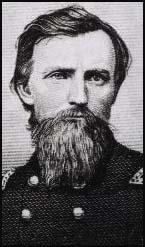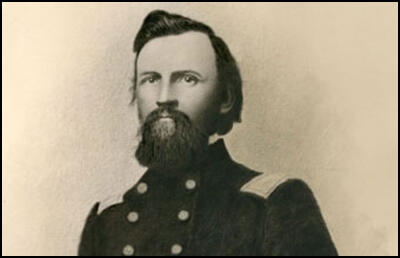Hans C. Heg

Hans Christian Heg was born in Lier, Norway, on 21st December, 1829. His family emigrated to America when he was eleven years old. Heg settled in Waterford, Wisconsin and in 1851 married Gunild Einong.
Heg was a Major in the 4th Wisconsin Militia and became the first Norwegian to be elected to state office when he became State Prison Commissioner of Wisconsin.
On the outbreak of the Civil War Heg joined the Union Army and was given the rank of Colonel and was heavily involved in recruiting the 15th Wisconsin, the Scandinavian Regiment.
Heg led the regiment during the successful raid on Union City, Tennessee. After an extensive campaign in Tennessee, Mississippi, and Alabama, Heg took part in the battle at Perryville (8th October, 1862). He was injured when his horse fell and was sent back to Wisconsin to recover.
Back on duty he led the capture of a Confederate artillery battery at Knob Gap, Tennessee (15th December, 1862). He then commanded the Scandinavian Regiment during the battle of Murfreesboro (Stones River). Despite suffering serious losses his brigade commander reported: "Colonels Alexander and Heg, in my opinion, proved themselves the bravest of the brave. Had such men as these been in command of some of our brigades, we should have been spared the shame of witnessing the rout of our troops and the disgraceful panic, encouraged, at least, by the example and advice of officers high in command."

In May, 1863, Heg was placed in command of the newly formed 3rd Brigade of the 1st Division, 20th Army Corps. On 29th August he led an early morning assault across the Tennessee River. The 3rd Brigade crossed over without a single casualty, therefore becoming the first Union troops south of the river.
Heg, about to be promoted to the rank of Brigadier General, led his men at Chickamauga in Georgia (19th September, 1863). Around 5 o'clock, just before the fighting finished, Heg was shot in the abdomen. Heg was taken to the Field Hospital at Crawfish Springs, but died the following day. Hans Christian Heg, the highest ranking officer in the Union Army in Wisconsin to be killed, is buried in the Norway Lutheran Church Cemetery in Racine County.
Primary Sources
(1) Official citation after the battle at Murfreesboro (1862)
I deem it my duty to call the special attention of the general commanding the Fourteenth Army Corps to Col. John W. S. Alexander, Twenty-first Illinois Volunteers, and Col. Hans C. Heg, Fifteenth Wisconsin Volunteers. While every field officer under my command did his duty faithfully, Colonels Alexander and Heg, in my opinion, proved themselves the bravest of the brave. Had such men as these been in command of some of our brigades, we should have been spared the shame of witnessing the rout of our troops and the disgraceful panic, encouraged, at least, by the example and advice of officers high in command.
(2) Ole Steensland, description of the battle at Murfreesboro (1863)
Then came the gloomy morning of the 20th when the few of us that were left formed into line of battle. We had orders not to retreat in face of the fact that four strong columns of rebels were charging our weak and scattered line. These were nerve straining moments when boyhood chums were dropping dead or wounded all around me. Ole Milestone [Milesten] was killed on my right, Chris [Christian] Thompson on my left. I got a bullet through my hat and that did no harm, but I was taken prisoner, and that was something that did hurt.
(3) Stephen O. Himoe, the surgeon who treated Hans Heg at the battle at Murfreesboro, later commented on what had happened.
Friends who called to see him, wept like children. Everybody who knew him loved him. He was not only a noble patriot, but a true Christian and died peacefully and calmly, fully persuaded of a glorious immortality through Jesus.
(4) General William Rosecrans on the death of Colonel Hans Heg (September, 1863)
His bravery, demonstrated in many engagements, is unquestioned. It is not however, the reckless daring of an unskilled and careless man, but the cool and determined valor of a competent, thoughtful commander. He is prudent, but not timid; deliberate, but not slow in movement. In person he is of medium size, rather slender, and with features more than ordinarily prepossessing. With the courage he has power of endurance so natural to the Scandinavian, and well calculated to share the hardships and privations of a march as he directs the movements of his command.

